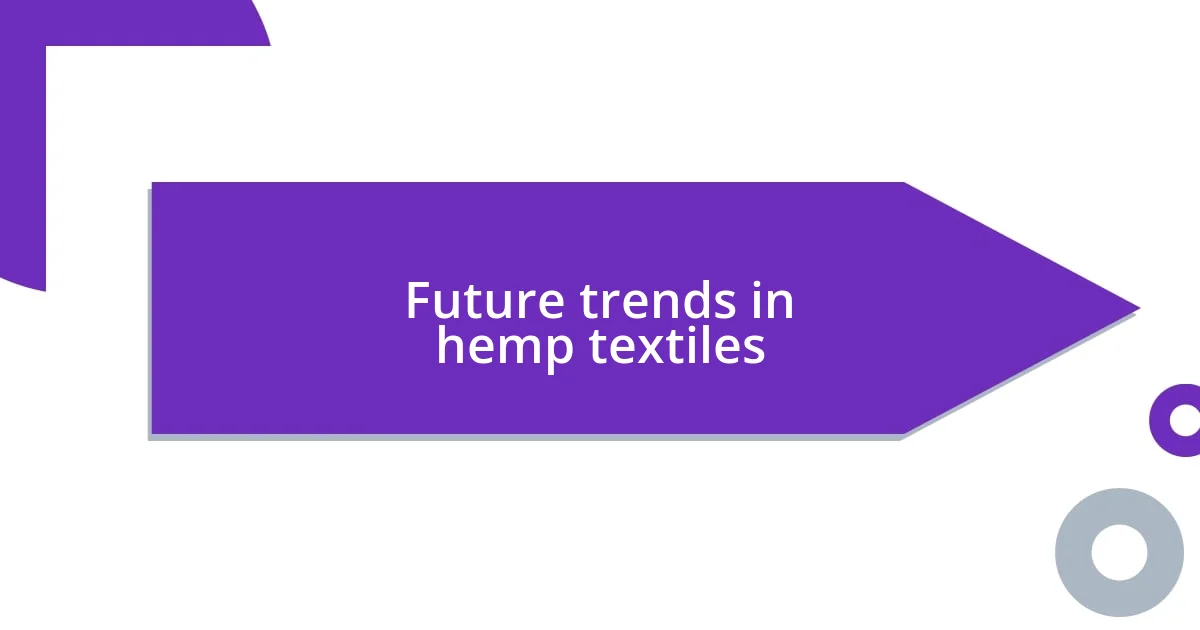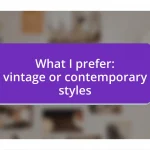Key takeaways:
- Hemp textiles are eco-friendly, durable, and breathable, making them ideal for a sustainable wardrobe.
- Sourcing quality hemp from reputable suppliers and embracing ethical labor practices enriches the textile production process.
- Future trends include innovative blends with other sustainable fibers and a focus on biodegradable alternatives in fashion, supporting a greener future.

Introduction to hemp textiles
Hemp textiles have captured my attention, and for good reason. This remarkable plant has been used for thousands of years, and I often find myself amazed by its versatility. Whether it’s for clothing, home goods, or beyond, the benefits of hemp fibers seem endless.
Each time I touch hemp fabric, I’m reminded of the unique texture that feels both sturdy and luxurious. Isn’t it fascinating how something so durable can be environmentally friendly? I sometimes reflect on the ancient traditions of hemp cultivation and wonder why it took so long for the modern world to fully embrace this resource.
As I explore the world of sustainable textiles, I can’t help but feel a sense of excitement about hemp’s potential. Beyond its strength and durability, its breathability and moisture-wicking properties make it ideal for garments. How can we not appreciate a fabric that not only feels good but also supports a healthier planet?

Benefits of using hemp
Hemp’s benefits go beyond what meets the eye. I remember the first time I made a shirt from hemp; the comfort and breathability were a delightful surprise. It’s not just me; many people appreciate how hemp fibers regulate temperature and wick moisture away, making it a perfect choice for warm days. The natural toughness of hemp means my garments last longer, reducing the frequency of replacements—a win for both my wallet and the environment.
Here are some key benefits of using hemp in textiles:
- Eco-Friendly: Hemp grows quickly and requires minimal pesticides, making it a sustainable crop.
- Durability: Hemp fibers are known for their strength, ensuring long-lasting products.
- Breathability: The fabric allows air circulation, keeping the wearer cool and comfortable.
- Antimicrobial Properties: Hemp has natural resistance to mold and bacteria.
- UV Resistance: This textile can provide protection against harmful sun rays, perfect for outdoor wear.
- Biodegradable: Hemp products break down naturally, reducing landfill contributions.
Each aspect of hemp not only enhances my wardrobe but contributes positively to our planet, making me feel good about my choices.

Sources for quality hemp
Finding quality hemp can be a rewarding journey. I’ve always prioritized sourcing from reputable suppliers because the fabric’s quality truly impacts its performance and durability. When I first began exploring hemp textiles, discovering local farms that practice sustainable cultivation made a world of difference—it’s like connecting directly with the roots of the production process.
As I dove deeper into this world, I noted several online sources that stood out. These platforms not only offer a variety of hemp textiles but also provide insights into their sourcing practices. One memorable experience was ordering from a company that sent me a detailed description of their hemp’s journey from farm to fabric. It felt good knowing my purchase supported ethical practices and sustainable communities.
I’ve learned that both local farms and online platforms can be excellent sources for quality hemp. The key is to look for transparency, as knowing the origins can enrich my textile choices. Here’s a comparison table highlighting some notable sources:
| Source | Type |
|---|---|
| Local Hemp Farms | Direct supply, sustainable practices |
| Online Retailers | Diverse offerings, easy access |
| Specialty Textile Suppliers | High quality, often organic |

Techniques for incorporating hemp
When incorporating hemp into textiles, I often experiment with different blending techniques. For instance, mixing hemp with organic cotton creates a fabric that’s both soft and durable. Have you ever tried blending fibers? I found that the result is not only aesthetically pleasing but also enhances the product’s overall performance.
Another technique I enjoy is using hemp yarn in knitting and weaving. The unique texture of hemp adds an interesting dimension to any project. Just imagine the satisfaction of creating a beautiful scarf that’s not just stylish but also eco-friendly. Each time I wear one of my handmade pieces, I feel a sense of pride knowing it supports sustainable practices.
Lastly, I’ve discovered that dyeing hemp fabrics can lead to stunning results. Using natural dyes, like indigo or madder, brings out the depth of color while maintaining the earthy vibe of the hemp. I remember my first attempt at natural dyeing; the process was so gratifying, and the colors turned out vibrant yet organic. What better way to showcase hemp’s versatility than to create textiles that tell a story with every shade?

Sustainable practices in hemp textiles
In my journey with hemp textiles, I truly appreciate the environmental benefits that this plant offers. For example, hemp grows rapidly without the need for pesticides or herbicides. I remember the first time I saw a field of hemp: it was refreshing to know that these resilient plants not only provide fiber but also help regenerate soil health. How remarkable is it that such a versatile crop can contribute positively to the ecosystem?
Additionally, I’ve noticed that many brands champion eco-friendly practices by utilizing every part of the hemp plant. From the stalks that become fibers to the seeds that offer nutritious oil, this plant doesn’t go to waste. I’ll never forget visiting a workshop where artisans created beautiful accessories using leftover hemp scraps; it was inspiring to witness creativity aligning with sustainability. Isn’t it exciting to think about how we can reduce our environmental footprint while still enjoying high-quality textiles?
Moreover, I like to support brands that prioritize ethical labor practices in their production processes. Knowing that the individuals involved in creating hemp textiles are treated fairly adds another layer of value to my purchases. During a visit to a local co-op, I met some of the workers who explained the importance of fair wages and safe working conditions. Their passion for their craft resonated with me deeply. This commitment to ethical practices ensures that every piece I incorporate into my work not only looks good but feels good to support. How does that resonate with your own values?

Future trends in hemp textiles
As I look ahead into the world of hemp textiles, I see a growing trend towards innovative blends with other sustainable fibers. For instance, incorporating hemp with Tencel not only enhances the softness but also amplifies the breathability, making it ideal for activewear. I remember trying out a hemp-Tencel blend for a pair of yoga pants; wearing them felt like embracing sustainability without sacrificing comfort. Have you considered how these blends can transform your wardrobe?
Another exciting trend is the increasing interest in hemp’s potential for biodegradable alternatives in the fashion industry. I’ve crafted a number of items using 100% hemp which break down naturally, leaving no harmful waste behind. It’s a beautiful thought that one day, my worn-out textiles might enrich the soil rather than sit in a landfill. Doesn’t that spark a sense of hope for a greener future?
Moreover, the resurgence of traditional weaving techniques in crafting hemp textiles truly captivates me. I’ve witnessed skilled artisans reviving age-old methods, infusing modern designs with cultural heritage. The intricate patterns they create tell stories and elevate the textile beyond mere fabric. When I wear something handmade from these crafts, I’m reminded of the rich history and community behind each piece. Isn’t it remarkable how fashion can serve as a bridge between the past and a sustainable future?














